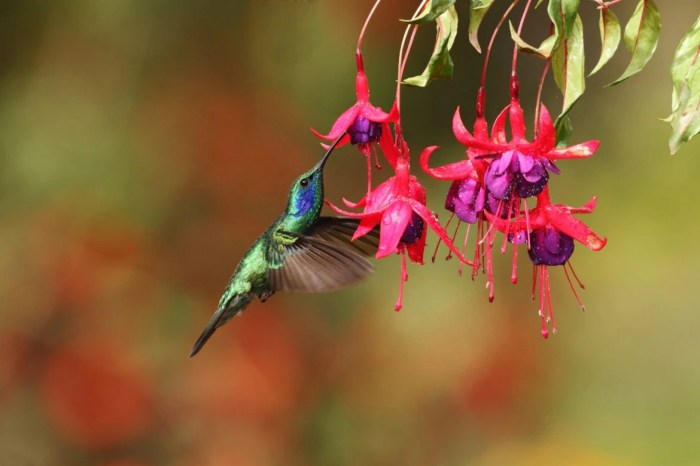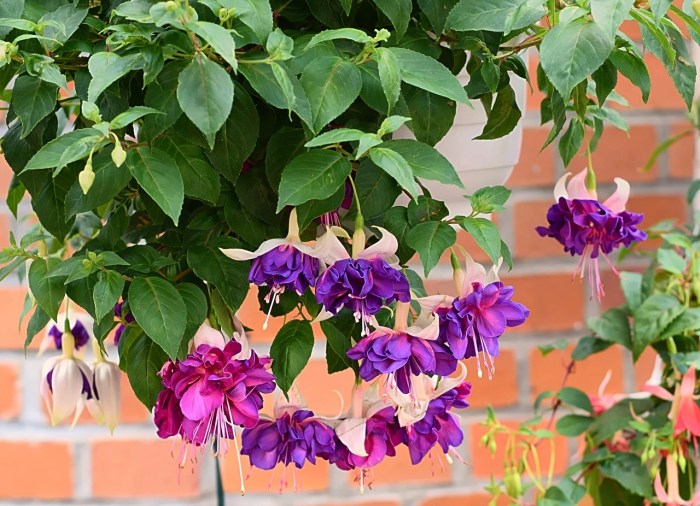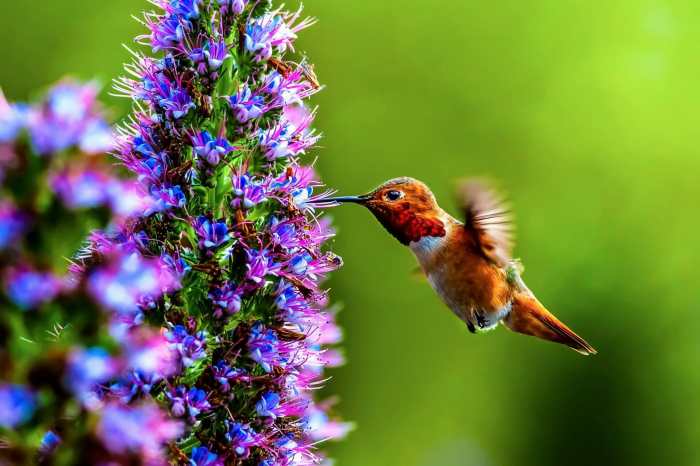What hanging plants attract hummingbirds – Discover the captivating world of hummingbird-attracting hanging plants in this comprehensive guide. Delve into the alluring characteristics that draw these vibrant creatures to your garden, creating a symphony of color and life.
From vibrant blooms to delectable nectar, we unveil the secrets of designing a hummingbird haven that will keep these feathered jewels fluttering back for more.
Hummingbird-Attracting Plant Varieties
Hummingbirds, known for their iridescent plumage and rapid wingbeats, are a joy to observe. Many plant species can attract these fascinating birds to your garden, providing both aesthetic beauty and a lively atmosphere.
Hanging plants, in particular, offer a convenient way to create hummingbird-friendly spaces. Their trailing stems and vibrant blooms create a welcoming environment for these aerial visitors.
Fuchsia Varieties
- Fuchsia magellanica(Hardy Fuchsia): Hardy in zones 6-9, this species produces abundant, pendulous flowers in shades of pink, purple, and white.
- Fuchsia boliviana(Bolivian Fuchsia): A tropical species suitable for hanging baskets, it features elongated, lantern-shaped flowers in vibrant shades of red, orange, and purple.
Begonia Varieties
- Begonia semperflorens(Wax Begonia): A popular choice for hanging baskets, this species offers continuous blooms in various colors, including pink, red, white, and yellow.
- Begonia boliviensis(Bolivian Begonia): Known for its cascading stems and clusters of pink or white flowers, this species attracts hummingbirds with its nectar-rich blooms.
Lantana Varieties
- Lantana camara(Common Lantana): A vigorous species with a wide color range, including yellow, orange, pink, and purple. Its clusters of small, fragrant flowers are a favorite among hummingbirds.
- Lantana montevidensis(Trailing Lantana): A more compact species suitable for hanging baskets, it produces trailing stems with clusters of yellow or orange flowers.
Flower Characteristics and Color Preferences

Hummingbirds are attracted to flowers that possess specific characteristics that cater to their unique feeding preferences and visual abilities. These characteristics include:
Shape
- Hummingbirds prefer flowers with tubular or trumpet-shaped corollas, which provide a narrow, elongated opening that allows their long, slender beaks to reach the nectar deep within.
Size
- Small to medium-sized flowers, typically ranging from 1 to 2 inches in length, are ideal for hummingbirds, as they can easily maneuver around the flower and access the nectar.
Color Preferences
Hummingbirds are particularly drawn to flowers in shades of red, orange, and pink. These vibrant colors stand out against the greenery of foliage, making them highly visible to the birds’ keen eyesight.
Hummingbirds also exhibit a preference for flowers with iridescent or metallic markings, which create a shimmering effect that attracts their attention. These markings enhance the visibility of the flowers and guide the birds to the nectar source.
When it comes to attracting hummingbirds, hanging plants play a vital role. Some of the best options include fuchsia, honeysuckle, and trumpet vine. These plants offer nectar-rich flowers that hummingbirds find irresistible. If you’re looking for a convenient way to incorporate these plants into your home, consider checking out the selection of bunnings indoor hanging plants . They offer a wide variety of options that are perfect for attracting hummingbirds and adding a touch of beauty to your indoor space.
Nectar Production and Sugar Content

Nectar production is paramount for attracting hummingbirds to hanging plants. These tiny birds rely heavily on nectar as their primary source of energy. Nectar is a sugary liquid produced by flowers that provides hummingbirds with essential nutrients, including carbohydrates and sugars.
Ideal Sugar Content
The sugar content of nectar is a critical factor in attracting hummingbirds. Hummingbirds prefer nectar with a sugar concentration between 15% and 25%. This range provides them with the optimal balance of energy and nutrients. Nectar with a sugar concentration below 10% is not sufficiently energy-rich, while nectar with a concentration above 30% can be too thick and difficult for hummingbirds to digest.
Planting and Care
Hummingbird-attracting hanging plants thrive in specific conditions to produce abundant nectar and support their growth. Understanding their ideal environment and implementing proper care practices ensures plant health, longevity, and a continuous source of hummingbird sustenance.
Light Requirements
Most hummingbird-attracting plants prefer full to partial shade. Direct sunlight can scorch their delicate leaves, especially during hot summer months. Place hanging baskets in areas that receive morning sun and afternoon shade, such as under trees or on east-facing porches.
Soil Considerations
Well-draining soil is crucial for hanging plants to prevent waterlogging and root rot. Use a potting mix specifically formulated for container gardening, which typically contains a blend of peat moss, perlite, and vermiculite. Amend the soil with compost or organic matter to enhance nutrient content and water retention.
Watering Needs
Water hanging plants regularly, especially during hot, dry weather. Allow the soil to dry out slightly between waterings to avoid overwatering. The frequency of watering will vary depending on the plant species, pot size, and environmental conditions. Check the soil moisture level by inserting your finger into the potting mix.
Water when the top inch or two feels dry.
If you’re looking to attract hummingbirds to your garden, consider hanging plants that produce tubular flowers. These include fuchsias, lobelia, and penstemons. You can easily hang these plants in bunnings fence hanging pots to create a vertical garden that will attract these colorful birds.
Hummingbirds are attracted to the nectar produced by these flowers, so make sure to plant a variety of species to keep them coming back all season long.
Fertilization
Fertilize hanging plants every few weeks during the growing season with a balanced liquid fertilizer diluted to half strength. Avoid over-fertilizing, as it can burn the roots and damage the plant. Use a fertilizer specifically designed for flowering plants to promote nectar production.
Hanging plants are a great way to attract hummingbirds to your garden. Some of the best hanging plants for hummingbirds include fuchsias, begonias, and impatiens. These plants produce brightly colored flowers that are rich in nectar, which hummingbirds love. You can find a wide variety of hanging plant pots at Bunnings, including bunnings hanging plant pots that are specifically designed to attract hummingbirds.
By choosing the right hanging plants and pots, you can create a beautiful and inviting space for these fascinating creatures.
Pruning and Maintenance, What hanging plants attract hummingbirds
Regular pruning helps maintain plant shape, encourage new growth, and remove dead or spent blooms. Pinch back the tips of stems to promote bushier growth and more flowers. Deadhead spent blooms to prevent seed formation and encourage continuous blooming. Inspect plants regularly for pests or diseases and treat them promptly to prevent damage.
Design Considerations for Hummingbird Gardens

Designing a hummingbird garden using hanging plants requires careful consideration of various factors to create a visually appealing and functional space that attracts these vibrant birds. By incorporating the following principles, you can create a hummingbird oasis that provides ample nectar, shelter, and aesthetic beauty.
Hanging Plant Selection
Choose hanging plants that are known to attract hummingbirds, such as fuchsia, trumpet honeysuckle, and pentas. These plants produce abundant nectar and colorful blooms that are irresistible to hummingbirds. Consider plants with tubular or trumpet-shaped flowers, as they are well-suited for hummingbirds’ long, slender beaks.
Vertical Gardening
Hanging plants allow for vertical gardening, which is particularly beneficial in small spaces or urban areas where ground space is limited. Vertical gardening creates multiple levels of nectar sources, allowing hummingbirds to feed at different heights and reducing competition. It also adds visual interest and depth to your garden.
Grouping and Spacing
Group hanging plants with similar bloom times to create a continuous supply of nectar throughout the season. Plant them in close proximity to provide easy access for hummingbirds, but ensure there is enough space between plants for airflow and to prevent overcrowding.
Water Feature
Incorporate a small water feature, such as a birdbath or misting fountain, into your hummingbird garden. Hummingbirds need water for drinking, bathing, and regulating their body temperature. A water feature will attract hummingbirds and provide a refreshing respite.
Shelter and Perches
Provide shelter for hummingbirds by planting shrubs or small trees nearby. These plants offer protection from predators and inclement weather. Additionally, include perches such as branches or wires where hummingbirds can rest and observe their surroundings.
Last Recap

As you embark on this enchanting journey, remember that providing a welcoming environment for hummingbirds is not only a feast for their senses but also a testament to the delicate balance of nature. Embrace the beauty of these tiny marvels and let their presence transform your garden into a sanctuary of joy and wonder.
FAQ Insights: What Hanging Plants Attract Hummingbirds
What are some common hanging plants that attract hummingbirds?
Fuchsia, honeysuckle, petunia, lobelia, and lantana are popular choices.
What flower colors do hummingbirds prefer?
Hummingbirds are particularly drawn to red, orange, and pink flowers.
How can I ensure my hanging plants produce enough nectar?
Fertilize regularly and provide ample sunlight to promote nectar production.